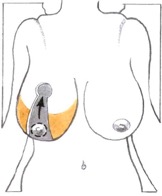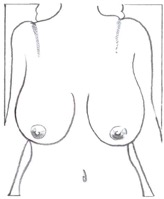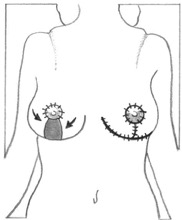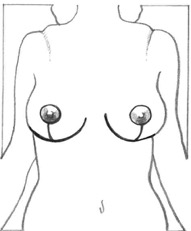

WHAT TO EXPECT
- Anesthesia: General
- Length of surgery: 2 – 4 hours
- Outpatient/inpatient: Outpatient
- Adjunct procedures: Breast lift, Mommy Makeover, liposuction
- Recovery: 2 – 6 weeks
Women with large, pendulous and heavy breasts may experience a variety of medical problems caused by excessive weight of the breasts. Back and neck pain, skin irritation, bra strap grooving and postural problems are only some of the issues. Other common problems are restriction of physical activities, difficulty with clothes fitting well and feeling socially self-conscious.
CHOOSING THIS SURGERY
Breast reduction surgery (also called reduction mammoplasty) is a procedure designed to reduce the breast size and weight. For breasts that are wider, longer and larger than ideal, breast reduction surgery will reduce these variables. The procedure removes breast glands, skin and fat, and can reduce areolar diameter. The breast will be lighter, smaller, firmer and more in proportion to the rest of the body.
PREPARING FOR SURGERY
Most women opting for breast reduction have breast size that is out of proportion to the rest of their body. In addition, patients who want a very active lifestyle find their breast size can interfere with comfort during movement. Breast reduction surgery is the answer to these issues. In most cases, breast reduction is performed on the fully mature breast – or after a woman is at least 18 years in age. There is no age criteria for a breast reduction, however the breasts should be a stable size for at least a year prior to considering a breast reduction. Younger women in the their teens and twenties that have breast reduction may be at increased risk for having recurrence of macromastia/large breasts. The procedure may be done at a younger age in cases of extreme early and robust breast development.
Your surgeon will ask about your medical history and your goals for breast reduction. Other criteria must be met for coverage, such as height, weight, the amount of breast tissue to be removed and previous non-surgical treatment methods.
During your initial examination, your surgeon will discuss options for surgery techniques and what you could expect for results. Age, skin laxity, weight and tissue quality all affect the procedure results and recovery.
Your surgeon may require a pre-surgery mammogram if you are > 40 years of age or have a family history of pre-menopausal breast cancer and a physical exam by your primary care physician to assure you are medically ready for surgery. Arrange for an adult to drive you home after surgery. You will also need an adult to stay with you the first night.
ABOUT THE SURGERY
Breast reduction is a complex procedure. Our surgeons at Edina Plastic Surgery have successfully performed this surgery for hundreds of patients. We have a special expertise in reduction mammoplasty and are board certified in the specialty of plastic surgery.
As with any surgery there are certain risks. Bleeding, infection, skin or nipple tissue loss, delayed healing and reactions to anesthesia are some of the possible surgery complications – but they are not typical or common. General anesthesia is used during the procedure and local anesthesia blocks can be used for post-surgery patient comfort. This procedure is done in our modern and accredited outpatient surgery center, which is attached to our clinic. For cosmetic procedures and certain insurance providers, otherwise done at a hospital.
Your surgeon will use scar reduction techniques like careful suturing, tape support and, on occasion, a topical cream. Scars will fade in color and intensity over time – generally one to two years. You should know, however, that breast reduction is a trade of large and heavy breasts for a more manageable size and shape with incisions and subsequent scars.
Techniques for breast reduction vary, but the most common procedure involves an anchor-shaped incision that circles the areola, extends downward, and follows the natural curve of the crease beneath the breast. The surgeon removes excess glandular tissue, fat, and skin, and moves the nipple and areola into their new position. Skin from both sides of the breast is moved down and around the areola, shaping the new contour of the breast. Liposuction may be used to remove excess fat from the armpit area.


Incisions outline the area of skin, breast tissue, and fat to be removed and the new position for the nipple.
In most cases, the nipples remain attached to their blood vessels and nerves. However, if the breasts are very large or pendulous, the nipples and areolas may need to be completely removed and grafted into a higher position. This will result in a loss of sensation in the nipple and areolar tissue.

Skin formerly located above the nipple is brought down and together to reshape the breast. Sutures close the incisions, giving the breast a new contour.
Stitches are usually located around the areola, in a vertical line extending downward, and along the lower crease of the breast. When only fat needs to be removed, liposuction alone can be used to reduce breast size, leaving minimal scars – although this is not covered by insurance.

Scars around the areola, below it, and in the crease under the breast are permanent, but can be easily concealed by clothing.
After surgery, you will be placed in an elastic bandage and gauze, or perhaps a post-surgical bra over gauze dressings. Typically no drains are used, but occasionally they are needed. Discomfort can be managed with prescribed pain medications. A brief course of antibiotics is also prescribed. You will return for a follow-up exam in one to three days.
Most patients return to work in about one week – and can resume other normal activities in four to six weeks. After a week of rest and recovery, other activities can be gradually increased as tolerated.
A sports bra or other good support garment may be the most comfortable during recovery, but that is a personal preference. Most swelling will subside in six to eight weeks; some swelling can linger for up to a year. Although much of the swelling and bruising will disappear in the first few weeks, it may be six months to a year before your breasts settle into their new shape. Fluctuations may continue in response to your hormonal shifts, weight changes and pregnancies.

Your surgeon’s techniques will make your scars as inconspicuous as possible. It’s important to remember that breast reduction scars are extensive and permanent. They often remain lumpy and red for months before gradually becoming less obvious, sometimes fading to thin white lines. The scars can usually be placed so that you can comfortably wear low-cut tops.
As much as you may have wanted and hoped for these changes, you’ll need time to adjust to your new image. So will your family and friends. Be patient with yourself, and with others. Keep in mind your original goals for this surgery.
Most women are very pleased with the surgery results. Of all the plastic surgery procedures, breast reduction results in the quickest body-image changes. You’ll be rid of the physical discomfort of large breasts, your body will look better proportioned and clothes will fit you better.

